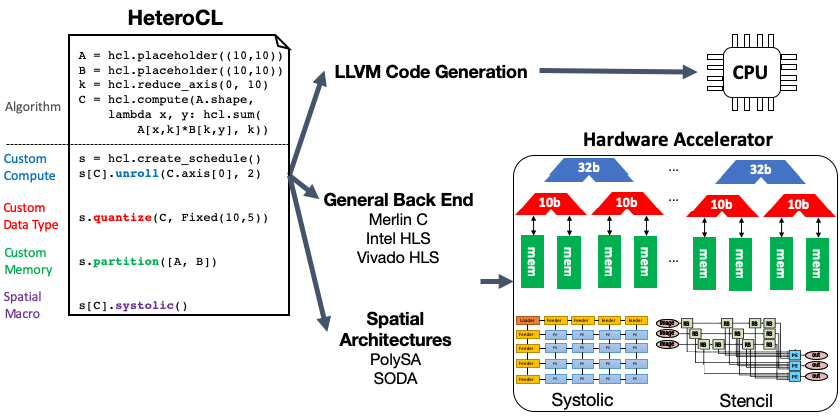Website | Installation | Tutorials | Samples | Documentation
With the pursuit of improving compute performance under strict power constraints, there is an increasing need for deploying applications to heterogeneous hardware architectures with accelerators, such as GPUs and FPGAs. However, although these heterogeneous computing platforms are becoming widely available, they are very difficult to program especially with FPGAs. As a result, the use of such platforms has been limited to a small subset of programmers with specialized hardware knowledge.
To tackle this challenge, we introduce HeteroCL, a programming infrastructure comprised of a Python-based domain-specific language (DSL) and a compilation flow. The HeteroCL DSL provides a clean programming abstraction that decouples algorithm specification from three important types of hardware customization in compute, data types, and memory architectures. HeteroCL can further capture the interdependence among these different customization techniques, allowing programmers to explore various performance/area/accuracy trade-offs in a systematic and productive manner. In addition, our framework currently provides two advanced domain-specific optimizations with stencil analysis and systolic array generation, which produce highly efficient microarchitectures for accelerating popular workloads from image processing and deep learning domains.
The speedup is over a single-core single-thread CPU execution on AWS F1.
| Benchmark | Data Sizes & Type | #LUTs | #FFs | #BRAMs | #DSPs | Freqency (MHz) | Speedup | Back End |
|---|---|---|---|---|---|---|---|---|
| KNN Digit Recognition Image classification |
K=3 #images=1800uint49 |
4009 | 5835 | 88 | 0 | 250 | 12.5 | General |
| K-Means Clustering |
K=16 #elem=320 x 32int32 |
212708 | 235011 | 32 | 1536 | 190.6 | 16.0 | General |
| Smith-Waterman Genomic sequencing |
string len=128uint2 |
110841 | 88369 | 1409 | 0 | 152.2 | 20.9 | General |
| Seidel Image processing |
2160 pixel x 3840 pixelfixed16 |
21719 | 31663 | 46 | 96 | 250 | 5.9 | Stencil |
| Gaussian Image processing |
2160 pixel x 3840 pixelfixed16 |
70833 | 131160 | 46 | 688 | 250 | 13.2 | Stencil |
| Jacobi Linear algebra |
2160 pixel x 3840 pixelfixed16 |
14883 | 22485 | 46 | 48 | 250 | 5.0 | Stencil |
| GEMM Matrix multiplication |
1024 x 1024 x 1024fixed16 |
454492 | 800283 | 932 | 2507 | 236.8 | 8.9 | Systolic Array |
| LeNet Inference CNN |
MNISTfixed16 |
362291 | 660186 | 739.5 | 1368 | 250 | 10.6 | Systolic Array |
If you use HeteroCL in your design, please cite our FPGA'19 paper:
@article{lai2019heterocl,
title={HeteroCL: A Multi-Paradigm Programming Infrastructure for Software-Defined Reconfigurable Computing},
author={Lai, Yi-Hsiang and Chi, Yuze and Hu, Yuwei and Wang, Jie and Yu, Cody Hao and
Zhou, Yuan and Cong, Jason and Zhang, Zhiru},
journal={Int'l Symp. on Field-Programmable Gate Arrays (FPGA)},
year={2019}
}
HeteroCL is a Python-based DSL extended from TVM and it extends Halide IR for intermediate representation. HeterCL incoporates the SODA framework, PolySA framework, and Merlin Compiler for FPGA back-end generation.
- Stencil with Optimized Dataflow Architecture (SODA)
- Polyhedral-Based Systolic Array Auto-Compilation (PolySA)
- Merlin Compiler
- Halide
- TVM
- Use Pull Request.
- Python coding style.
- Python docstring style.

